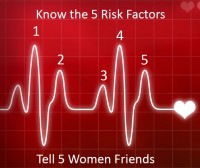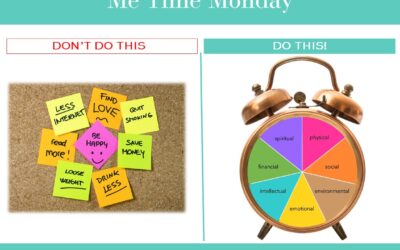 Every October we are immersed in a sea of pink – the color for breast cancer awareness – yet the No. 1 killer of women in America remains heart disease. In fact, twice as many women die from stroke or cardiovascular disease than all cancers combined, including breast cancer. More than 1 in 3 women will die from heart disease this year – one every minute.
Every October we are immersed in a sea of pink – the color for breast cancer awareness – yet the No. 1 killer of women in America remains heart disease. In fact, twice as many women die from stroke or cardiovascular disease than all cancers combined, including breast cancer. More than 1 in 3 women will die from heart disease this year – one every minute.
This February, the American Heart Association kicks off its 10th anniversary of its Go Red Campaign in an effort to paint the town red and get women to stop and understand the truth of their heart disease risks. Over the last 10 years the campaign’s success has paid off with amazing results:
- More than 627,000 women’s lives have been saved through awareness and education – that is 330 lives per day
- Almost two million women have completed the Go Red Check-up – a 10-fold increase since 2003
- Women have changed their heart risky behaviors – smoking has decreased 15 percent, 1 in 2 women have increased their exercise and cholesterol levels are 6-18 percent lower for those with readings over 200
“Women who Go Red have the awareness and are more empowered to make lifestyle changes,” says Dr. Suzanne Steinbaum, Go Red cardiologist and author of Dr. Suzanne Steinbaum’s Heart Book: Every Women’s Guide to a Heart Healthy Life. “Nine out of 10 of the women who visit our web site have made at least one healthy behavior change. But we still need to spread the word because there is a disconnect between women knowing about heart disease as the No. 1 killer and understanding their personal risk.”
One woman who became the most unlikely poster woman for heart disease is Dianne Kane-McGunigle of Quincy, Mass. The 53-year-old platinum blonde stunner was always fit and healthy working as a personal trainer and fitness instructor and running marathons on weekends. The mother of two had grown girls had always watched her numbers – things like weight, cholesterol and blood pressure and according to her doctor was as healthy as a woman at least a decade younger.
But one day last year, Dianne clutched her chest, hit the floor and found her police officer husband rushing her to emergency. All she could think about was, “Please don’t let this be bad – I haven’t had grandchildren yet.”
“I come from tough Irish stock and in retrospect I was overlooking some small warning signs because in my family you just tough it out,” says Dianne.
A couple of days before this emergency, Dianne had experienced some acid reflux and her forearms were achy and kind of numb. She chocked it up to pushing herself too hard in recent workouts. But the night before her attack she had tiny spasms in her heart and she started sweating and feeling nauseous. Next thing she knew she was on the floor and then in the hospital.
“Heart disease in women often presents differently than what we see in men,” says Dr. Steinbaum. “It can be a sudden chest pain, such as what Dianne experienced, but it can also be more subtle – shortness of breath, jaw pain, back pain, flu-like symptoms, difficulty sleeping and the symptoms Dianne experienced such as nausea and vomiting.”
In addition, women who are caregivers – caring for an older parent or spouse with a devastating disease – are at greater risk for heart disease because of the prolonged emotional stress of caregiving, neglect of their own health and wellness needs and a tendency to adopt or rekindle bad habits such as smoking.
The ER doctors ran tests and told Dianne she was fine and was probably just experiencing a panic attack or had over-exerted herself at the gym. But Dianne knew better.
“If I have any message for women out there – it is to be an aggressive advocate in your health and the health of your loved ones,” she says. “I knew something was really wrong and I wasn’t going to be ushered out of the hospital as someone who just had a simple panic attack.”
She begged a kind nurse to run more tests. “I’m dying,” Dianne told the nurse. “You have to help me.”
Additional tests found that indeed Dianne had suffered a heart attack known as a widow maker. This is a type of heart attack where it is a stenotic left main coronary artery – a blood clot prevents blood from pumping through the left descending artery often resulting in a massive, sudden, fatal heart attack. This is the same kind of heart attack that Rose O’Donnell survived last year.
“My doctors and I truly believe if I had not been as fit as I was, I would surely be dead,” says Dianne.
The American Heart Association advises women to know five important things when it comes to heart disease:
1) Don’t smoke. Period.
2) Know your numbers – blood pressure, cholesterol, blood sugar (for diabetes risk which is tied to heart disease).
3) Maintain a healthy weight and BMI (body mass index) by eating nutritiously.
4) Have a consistent exercise schedule (it keeps your body fit and reduces stress).
5) Know your family history.
It is #5 that hit Dianne like a Mack truck. She had all the other items checked but she had no idea that in her family, the widow maker type of heart attack is on both sides of her family tree.
“That was my wake-up call,” says Dianne, who has an identical twin, Denise. Now this Go Red spokeswoman talks to other women about heart health and understanding each of the five things that could contribute to a life-altering event.
“Go Red encourages women to wear your red and tell five friends about the heart disease risk factors,” says Dianne. “I have five sisters, including my twin sister, and we’ve all talked about our family risk. I Go Red for them.”





Every weekend i used to pay a visit this site, because i want enjoyment, as this this web page conations in fact good funny information too.